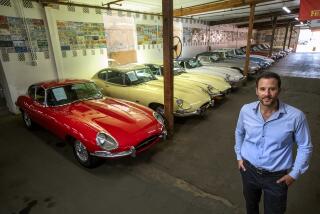High-Tech Auto Gear Roars Into Fast Lane : FULL BLAST
- Share via
At first glance, it might appear that the most valuable cargo in Mark E. Gassei’s white Toyota truck are the long rolls of wall covering he carries to show clients.
But inside the cab, Gassei--who heads his own home improvement company in Granada Hills--has more than $4,000 in fancy electronic accessories, including an elaborate stereo, a mobile telephone and an alarm to protect the equipment from thieves.
“I’m sure all of this stuff would intimidate my mother,” Gassei quipped.
Consumers such as Gassei last year spent about $2 billion on aftermarket electronic car accessories, according to the Boston-based consulting firm Venture Development Corp. and industry trade groups. Spending on so-called mobile electronics has increased 60% since 1983.
Virtually unknown six years ago, when radios and stereo tape players were the only electronic accessories in most cars, mobile electronics has grown into a technological tour de force in which telephones, alarms, compact disc players, radar detectors and other sophisticated gadgets compete for space in the dashboards of the well-heeled motorist.
Esoteric New Gadgets
Traditional car stereo installers are not the only ones to have benefited. The spending has created a market for esoteric new gadgets such as car alarms equipped with remote controls that can turn on your coffee brewer at home. The booming aftermarket of electronic car accessories--largely centered in California--has also attracted the interest of the big auto manufacturers, which are focusing more attention on developing fancy car stereos and alarm systems.
“The market is absolutely huge and growing,” said Michael William, sales promotion manager for the Delco Electronics unit of General Motors, which offers a $950 stereo and various security systems as options on several GM luxury and sports cars. “We’re very much interested in it.”
The growth of the mobile electronics industry is, in part, the result of new technology that has enabled engineers to design smaller yet more complex equipment. In particular, the audiocassette, which is less than half the size of the old eight-track tape cartridge, dramatically expanded the car stereo market.
But the growth of the market also reflects changes in American society.
Many urban workers, particularly in the West, now spend more time on crowded freeways and clogged streets and, thus, are willing to pay more for sound systems, telephones and other gadgetry to make their commute more convenient and pleasant.
“We identify so closely with our automobiles that it makes sense to think of them as extensions of the home,” psychologists Peter Marsh and Peter Collett wrote in their forthcoming book, “Driving Passion: The Psychology of the Car.”
Elaborate car gadgets, the two authors said, “allow the owners to pamper themselves and their passengers, but they also remind passengers of the owner’s inability to do without these important creature comforts.”
Replaces Speed Gear
Interest in such creature comforts is spreading beyond the music-obsessed urban youth and gadget- and security-conscious yuppies who started the mobile electronics trend about six years ago, experts say. Still, mobile electronics remains mostly a hobby for affluent young males.
“I’ve seen 16-year-olds spend $4,000 and up on car stereos alone,” said David Black, vice president of car stereo and alarm maker Alpine Electronics Inc. of Torrance. “Where they get the money, I don’t know. But these guys have systems that are mind boggling.”
“Passenger compartment amenities have really replaced the go-fast stuff in cars,” said Reese Haggot, former executive vice president of Alpine and now head of his own Los Angeles consulting firm. “It vents the competitive instinct of guys who used to drag (race) up and down Van Nuys or Lakewood boulevard.”
Dan Petersen, senior vice president of Kenwood U.S.A. Corp. in Torrance, said sales of car stereos, which had been booming for the past five years, have started to slow as the market matures. Still, business at most installation shops remains strong as consumer interest grows in newer products, such as car telephones and alarms. In fact, there are now a host of young companies, whose founders have parlayed backyard mobile electronic inventions into multimillion-dollar enterprises.
Cincinnati Microwave Inc., a 12-year-old Ohio firm that is one of the few publicly owned aftermarket manufacturers, earned $11.5 million last year on sales of $102 million, largely from the company’s $300 police radar detectors. And Vehicle Security Electronics Inc., a Southern California car alarm manufacturer founded nine years ago by Rudy Sanders and Lee Fleischman in a Chatsworth garage, now employs 50 people. The company won’t disclose annual sales, but a knowledgeable industry source says they exceed $4 million.
“When I came here six years ago, home stereo was bigger than our car stereo operation,” said Jim Higgins, owner of Sound Images, a home and mobile electronics dealer in Westwood. “Now the car end of the business accounts for 60% to 70% of our business.” And as technology reduces the size and cost of car phones, Higgins and other experts believe that the car phone business will grow even larger than car stereo.
New Competition
But the aftermarket electronics industry is feeling increasing competition from big auto makers, who have suddenly become interested in recapturing the mobile electronic market they once conceded to outside manufacturers.
Evidence of that pressure surfaced this month when the Car Audio Specialist Assn. in Washington announced that it plans to file a lawsuit against Chrysler, alleging that the auto maker restricts consumers’ ability to order cars without a factory-installed radio.
Chrysler did not respond to several requests to comment on the association’s announcement.
But the planned action is similar to a lawsuit the association brought seven years ago against General Motors. GM settled that suit out of court and agreed to permit consumers to order cars without factory-installed radios. Yet the percentage of cars ordered with radios remains high. The association claims that 72% of imports and 92% of domestic cars are ordered with a radio.
Car makers are also attempting to head off the aftermarket by increasing the “gee whiz” quotient of electronic gadgetry in their cars. Nearly all auto makers offer more elaborate car stereo systems. Several, including Saab, Mercedes-Benz, Mitsubishi, Corvette and Cadillac, offer electronic alarms.
The car makers’ push into the field has been aided by widespread complaints that many of the estimated 8,000 shops that install aftermarket car radios, alarms, telephones and other accessories have poorly trained personnel.
When Consumer Reports magazine attempted to have car alarm systems installed for testing last year, it reported finding that “having a system professionally installed can cause a lot of headaches.” In addition to improperly installed equipment, the magazine complained that installation fees varied as much as 100% for the same system in the same car.
Poor Training cited
“The aftermarket installation business has had to rely on a class of worker who has no formal training and whose job is to fit complex electronics into automobiles for which little room has been provided for additional electronic gadgetry,” noted John Runnett, former editor of Installation News, a trade publication. “There is a tremendous learning curve going on in the installation industry today.”
To improve the image, manufacturers have begun focusing on better training efforts. They are also staging contests to demonstrate that competent installers are capable of doing quality work.
For a car show at Cal State Northridge last weekend, installers at the Southern California car stereo chain Al & Ed’s managed to shoehorn more than $7,000 worth of electronic accessories into a 1986 Mercury Cougar.
In addition to a 300-watt, 13-speaker stereo system capable of playing AM/FM radio, tape cassettes and compact discs--the car has a mobile telephone, a remote police radar detector and a 27-function alarm system. Using a radio frequency-controlled switch similar to those in electronic garage door openers, the car alarm is able to do everything from remotely opening and closing car windows to turning on a pot of coffee in the owner’s house.
Television sets are also available with antennas for use in the car. It is, however, illegal to operate a motor vehicle with a television monitor forward of the rear of the driver’s seat or which is visible to the driver while operating the motor vehicle, according to a spokesman for the California Department of Motor Vehicles.
“When you spend 20% to 30% of the time in your car, your car is like your second office,” explained Al Brotsky, president of Al & Ed’s, which last year had sales of about $8 million. “And you want your car to be as comfortable as possible.”
Target of Thieves
That yearning has not gone unnoticed by thieves, who have also contributed to the burgeoning growth of mobile car electronics by stimulating more interest in car alarms.
Nationwide, There have been over 3 million car thefts and break-ins every year since 1980 and each year one out of every 48 cars are stolen are or vandalized by thieves, who take an average of $238 worth of car accessories, according to the National Automobile Theft Bureau of Palos Hills, Ill., an insurance industry group that promotes anti-theft campaigns.
“It stands to reason that expensive equipment is a lure,” said Theft Bureau spokesman Paul Gilliland. “Common sense would dictate that you’d keep such equipment to a minimum to avoid attracting the attention of thieves.”






